Junk Food’s Happiest Accident
For more than 50 years, cheese curls have been a staple of the modern junk food diet. You won't believe how we first discovered them.
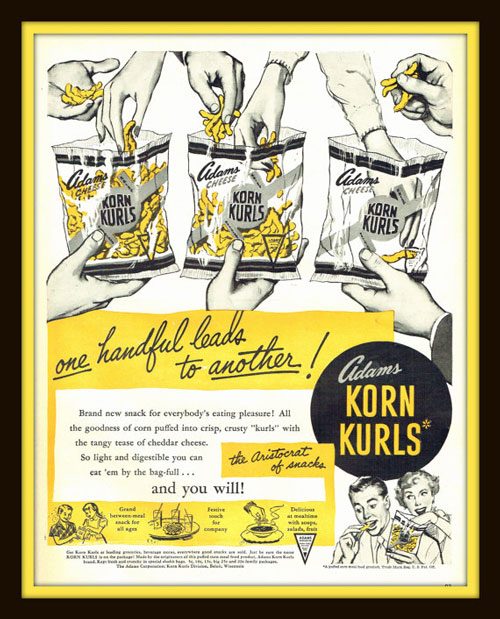
(via Etsy)
Who invented cheese curls? One story involves a piece of agricultural equipment
Wisconsin, the agricultural hub that it is, has given us a lot of food innovations over the years. (Three words: fried cheese curds.)
But some of those innovations, like the process that gave us the modern cheese curl, were complete accidents.
But the accident proved fruitful for Flakall Corporation, a Beloit, Wisconsin animal feed manufacturer whose owners later switched gears to producing snack foods, all thanks to the way the company cleaned its machines. The company’s approach to producing animal feed was to put the material through a grinder, effectively flaking out the corn so more of it could be used to get as much usable material as possible from the grain, as well as to ensure cows weren’t chewing any sharp kernels.
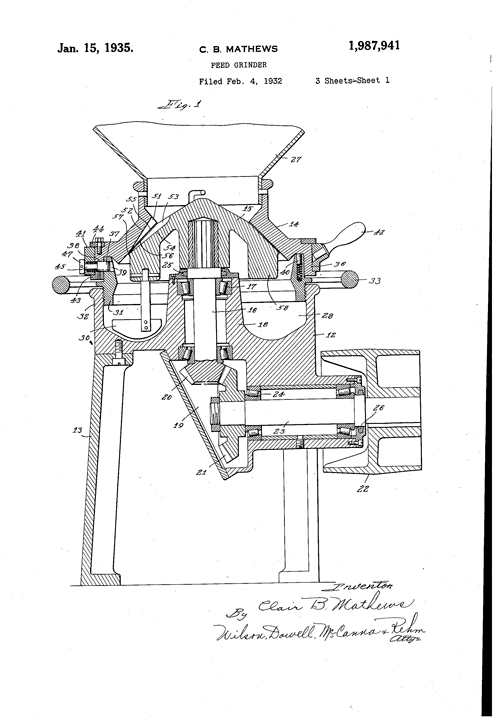
A feed grinder. (patent filing)
“This flaking of the feed is of advantage because it avoids loss of a good percentage of material which otherwise is thrown off as dust, and gives a material which keeps better in storage by reason of the voids left between the flakes, such that there can be proper aeration, not to mention the important fact that flaked feed is more palatable and easily digested by the animal,” the firm stated in a 1932 patent filing.
The grinder did its job, but it wasn’t perfect, and periodically required cleaning to ensure it wouldn’t clog. One strategy that Flakall workers used was to put moistened corn into the grinder. During this process, however, something unusual happened: the moist corn ran directly into the heat of the machine, and when it exited the grinder, it didn’t flake out anymore—it puffed up, like popcorn, except without the annoying kernels.
By complete accident, Flakall had invented the world’s first corn snack extruder.
Edward Wilson, an observant Flakall employee, saw these puffs come out of the machine, and decided to take those puffs home, season them up, and turn them into an edible snack for humans—a snack he called Korn Kurls.
Another way to put this is that when you’re eating a cheese curl, you’re noshing on repurposed animal feed.
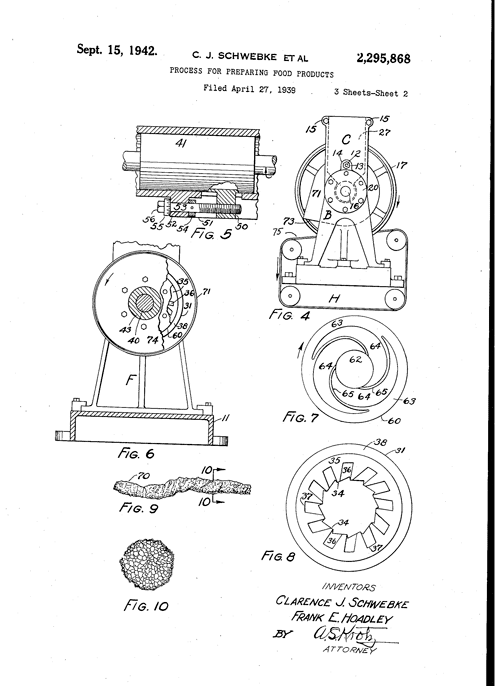
How a cheese curl is made. (patent filing)
This state of affairs led to the second patent in Flakall’s history, a 1939 filing titled “Process for preparing food products.” A key line from the patent:
The device preferably is designed so as to be self-heated by friction between the particles of the material and between the particles and the surfaces of contacting metal and to progressively build up pressure during the heating period. Thus the uncooked raw material, having a predetermined moisture content is processed into a somewhat viscous liquid having a temperature high enough to cook the mass and heat the water particles to a temperature high enough for evaporation at atmospheric pressure but being under sufficient pressure to prevent it.
If that’s a little complicated to understand, a 2012 clip from BBC’s Food Factory does the trick.
In the video, host Stefan Gates takes an extruder and connects it to a tractor, making the extruder move so fast that it puffs the corn out in an extremely fast, extremely dramatic way.
Clearly, Flakall had something big. The firm eventually changed its name to Adams Corporation, which helped take some attention off the fact that it was selling a food product to humans that was originally intended for cows.
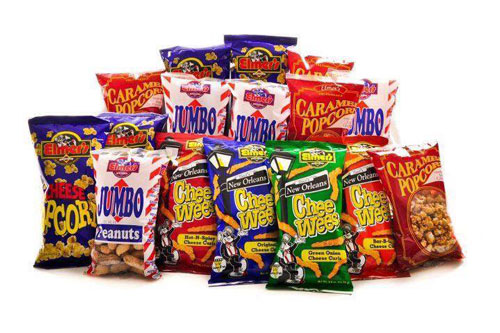
The other claimed inventor of cheese curls bounced back from natural disaster
While Flakall has the more interesting tale on this front, it’s not the only one. Another early claimant to the cheese curl is a Louisiana firm called the Elmer Candy Corporation, which developed a product eventually called Chee Wees.
The Big Cheese of New Orleans, as it’s nicknamed, became a local institution. (Unlike Zapp’s, another local snack-food icon whose excellent Voodoo chips have a cult following, Chee Wees haven’t gone national. Perhaps they should.)
Elmer’s Fine Foods—no longer a candy company—is a family-owned business that’s produced cheese curls mostly continuously for roughly 80 years.
I say “mostly,” of course, because the firm had to deal with the impact of Hurricane Katrina. As the company explains on its website, Elmer’s entire facility was flooded out by the deadly storm, and the company had to stop operation for 16 months while it recovered from the hurricane and completely replaced the machines that produced the snacks.
A challenge like that might have been enough to kill a lot of companies. But Elmer’s bounced back—and it’s still active to this day.
(Another notable cheese curl firm, Old London Foods, came out with its variation, the Cheese Doodle, in the late 1950s.)
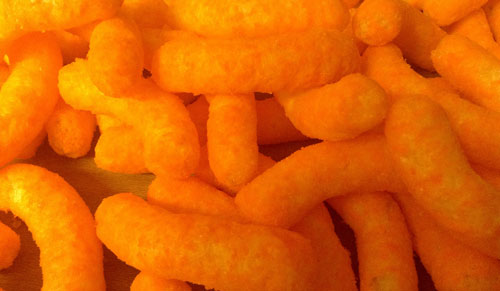
Five interesting facts about Cheetos, the brand that took cheese curls mainstream
- While Cheetos came along later than its competitors, first being invented in 1948, it quickly overtook the market, in part because it had gained national distribution due to the prior success of Fritos. That company’s founder, Elmer Doolan, worked out a deal with H.W. Lay and Company to market Cheetos to the broader market. It quickly became a massive hit.
- Cheetos are by far the most popular brand of cheese curls in the United States: According to Statista, the Cheetos brand had an estimated $969.5 million in sales in 2016, with the next most popular brand being Frito-Lay’s more-upscale Chester’s brand, which garnered up just 7 percent of Cheetos’ total sales.
- The success of Cheetos was so impressive that it played a large role in the merger of Frito with Lay in 1961, as well as the company’s later merger with PepsiCo just four years later.
- There are two main varieties of Cheetos—crunchy, the most common kind, and puffed, which only came about in 1971 or so. Each is made through different variations on the corn snack extruder process. Dozens of other flavors exist, however, both inside and outside of the U.S.
- The reason that Flamin’ Hot Cheetos have such a prominent color that sticks to everything (and turns your fingers red), according to Wired, has a lot to do with the product’s use of food dyes that have an added chemical to make the seasoning oil-dispersible. That’s because the powder won’t stick to the Cheetos without vegetable oils.
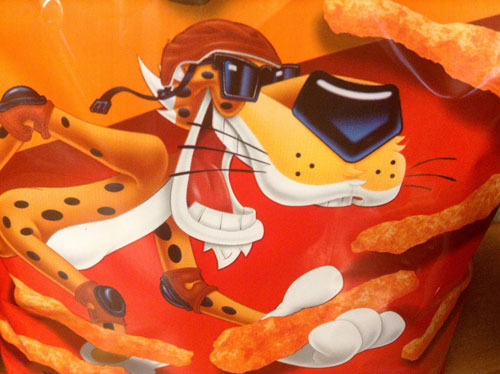
Cheese curl cartoons: Why we never got a Chester Cheetah Saturday morning cartoon, despite multiple attempts
These days, Chester Cheetah is trying to goad Beyoncé on Twitter just like every other advertising mascot worth its weight in salt, but there was a time that the cheetah was seen as so impressive that there was chatter it could become a cartoon lynchpin.
In fact, Frito-Lay got pretty far down the road with Fox in turning the mascot, launched in 1986, into a cartoon. Yo! It’s the Chester Cheetah Show, as the toon would have been called, was developed as a potential part of Fox’s Saturday morning cartoon slate. (CBS also considered making the show, but rejected it.)
Problem was, advocacy groups were not happy with the idea for the show, because of the fact that its roots were very clearly as advertising. Action for Children’s Television (ACT) and the Center for Science in the Public Interest (CSPI) were among the groups that petitioned the FCC regarding the program.
“His only previous television appearances, indeed his entire existence, have been in traditional commercial spots designed to sell a product,” the FCC petition stated, according to the New York Times.
ACT noted that it was rare to petition the FCC about a cartoon only in the planning stages, but felt it had to speak up due to what it felt was the unprecedented nature of the idea.
It didn’t help that Kraft was trying to sell Cheesasaurus Rex, its macaroni and cheese mascot, as a TV show around the same time.
Just a few weeks after the controversy blew up, Frito Lay and Fox shelved the idea, with Fox claiming that differences in creative control and long negotiations killed the show—not protests.
“I still believe he’s one of the best characters since Bugs Bunny, and the fact he is associated with a product was irrelevant to us,” Fox Kids President Margaret Loesch told the Times.
Frito Lay spokesman Tod MacKenzie, in comments to the Associated Press, was a bit more honest.
“Since Chester came out in 1986, he’s been wildly popular,” MacKenzie told the AP. “We don’t want to jeopardize the job he’s doing here.”
The book Saturday Morning Censors: Television Regulation Before the V-chip, published in 1998 by Duke University Press, pointed out that while ACT didn’t officially win the case with the FCC—which, during the Bush era, was in no mood to censor a show that wasn’t indecent—the group acted like it did, especially after its efforts also killed off the Cheesasaurus Rex show.
“We feel we have zapped, for the time being, the problem of logos turning into half-hour programs,” ACT President Peggy Charren stated at the end of the controversy.
But you still have to wonder what might have happened if the show got the green light after all this. ( This wiki page certainly does.) Would we be eating fewer cheese curls? Maybe more?
Clearly, the cheese curl has come a long way from the days when it was a happy agricultural accident.
But one firm that didn’t see the success of the Cheeto is the firm that was Flakall. Well, at least not directly. Its successor organization is a firm called Maddox Metal Works, which literally makes machines designed to manufacture corn-based foods. Here’s the one for cheese curls (Flash required).
The company acquired Flakall’s successor company, Adams International, in 1993. It was an acquisition that makes a lot of sense. See, in the 1950s, Maddox Machine Shop worked directly with the Frito company to build the machinery used to produce the company’s snack foods, and it grew from there.
In Beloit, Wisconsin, there is a Frito-Lay factory—a big one, one that the company has invested millions of dollars into. One that makes extruded snacks.
I’d like to think that a Frito-Lay executive put the factory there because they wanted this story to come full circle.
:format(jpeg)/2017/06/tedium111016.gif)
/2017/06/tedium111016.gif)

/uploads/ernie_crop.jpg)